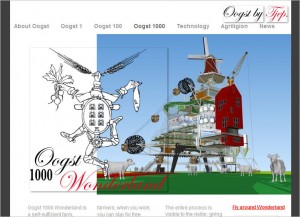Serendipity has led me to several items that are just so interesting I have to share. One actually has practical application, another is a cautionary tale—and the third is an inspiration.
Let’s start with the inspiration, since that’s connected with today’s eye-catching illustration. Yes! It’s a completely serious design for a “self-sufficient farm, restaurant, hotel and amusement park for 1,000 people per day.” In the Oogst 1000 Wonderland:
- Everything is linked by technology to create a self-sustainable system.
- All food for the restaurant comes from the farm.
- Visitors can learn about sustainable agriculture while they vacation.
The idea comes from Dutch design firm Tjep, and it’s part of a series that includes a house/farm that will provide one person with everything they need to live: greenhouse-grown food, solar and wind energy, and a completely self-contained oxygen atmosphere.
Relevance for the corporate website? Surprise your visitors, at least occasionally. Don’t just rely on “Careers page” stereotypes. Add some imagination.
The second item is more practical, although application in the recruiting sector looks to be still in the future. Mingle 360 has introduced a really fun and useful concept/product/service that let’s people use a gadget to exchange/capture information. The “MingleStick” is just a little bigger than a typical memory stick, and as of now, it’s mainly for use at events, such as tradeshows and conventions. Attendees use the MingleStick to click each other instead of exchanging business cards, and back home, they can see/store/organize their captured information in Mingle Manager.
There’s also social networking integration with Facebook, Twitter, and LinkedIn. And exhibitors can use a desktop MingleStation receiver that ties lead retrieval into the total package.
Some of my favorite career experiences have been associated with the tradeshow industry—and as a veteran on both sides of the aisle, I just see Mingle as a great idea. The current business model seems geared toward very large events (1000+), but it appears there would be a natural potential for use in more specialized settings, such as job fairs and career events. I’ve asked the company for additional information (including some ideas about cost-effectiveness) and will provide more Mingle info in a subsequent post.
The final idea is really only half-irresistible, but that was too long to explain in the post title. Mine Magazine, a personalized/customized print/online delivery platform from Time, Inc., got decidedly mixed reviews in its early outings. A few folks liked it much more than they expected to, while others really didn’t—and (as far as I know) there’s no telling yet whether the project will progress, morph, or die. But there is something important to consider about the attempt itself. That being:
Everyone recognizes that the whole process of information delivery is changing fast. Some of the familiar methods taken for granted in the past (print newspapers, for example, and broadcast television) are going to change radically in the future, while some of the newer formats we rely on today (like the website!) are already losing their effectiveness. So every smart company is looking for ways to change ahead of the curve, rather than falling behind.
The conventional corporate website is beginning to take on a “vintage” look–and nowhere is that more apparent than in the Careers sector. What’s the plan at your company for the evolution of web presence?
2010 is just around the corner . . .
Cynthia Giles has followed a serpentine career path from academia to publishing to marketing and design to information technology and corporate communications. There’s plenty of detail about this journey at www.cynthiagiles.com, but briefly--the common theme has been ideas, and how to present them effectively. Along the way, she became an accidental expert on data warehousing and business intelligence, and for the past ten years she has combined corporate contracting with an independent consulting practice that focuses on marketing strategy for smaller businesses and non-profits.
Having spent quite a bit of time looking for work, and anywhere from two weeks to two years inside a wide variety of American companies—she has given much thought to what works (and what doesn’t) when it comes to creating a great employment fit.
